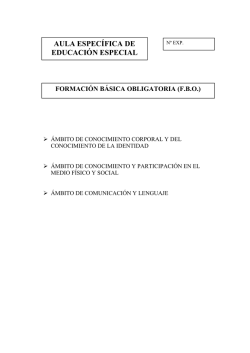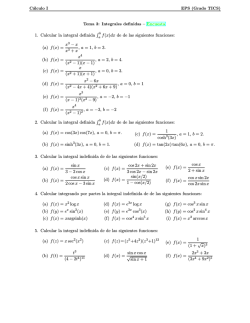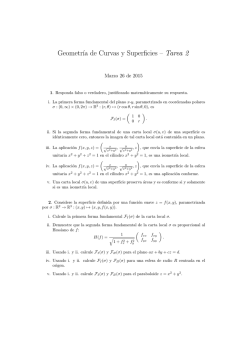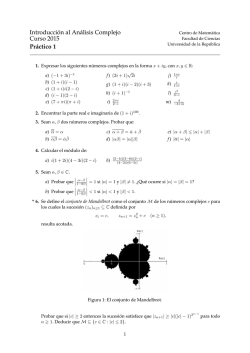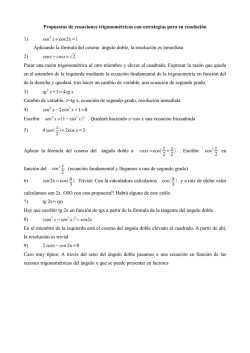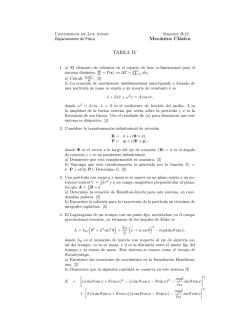
Slide 1 - licimep.org
Página del curso: http://www.licimep.org Francisco Soto Eguibar [email protected] Lunes 10 de octubre de 2016. Ejercicios suplementarios del capítulo 2, página 46: Todos los impares, del 2.35 al 2.55 (incluidos ambos) Lunes 17 de octubre de 2016. Ejercicios suplementarios del capítulo 2, página 46: Todos los impares, del 2.57 al 2.75 (incluidos ambos) Lunes 24 de octubre de 2016. Ejercicios suplementarios del capítulo 5, página 94: Todos los impares, del 5.25 al 5.39 (incluidos ambos) Viernes 28 de octubre de 2016. Ejercicios suplementarios del capítulo 5, página 94: Todos los impares, del 5.41 al 5.51 (incluidos ambos) Viernes 14 de octubre 15:00 horas Este mismo salón I. Variable compleja II.Análisis de Fourier III.Ecuaciones diferenciales •Introducción •Series de Fourier •Integrales de Fourier Una barra de largo L y muy delgada, de tal manera que podemos considerarla unidimensional, tiene sus extremos a temperatura cero y la distribución de temperatura a lo largo de ella es inicialmente hx y 0 xd d T ( x, t 0) y h( x L ) d x L d L Encontrar la temperatura en la barra como función del tiempo. 1 1 L 1; h ; d ; 4 3 T x, t t T x, t 2 k x 2 en una variable espacial y el tiempo T x, t T x, t k 2 t x 2 B 4 AC 0 2 Es una ecuación parabólica T x, t 2T x, t k es lineal 2 t x La combinación lineal T aT1 bT2 siendo T1 y T2 soluciones y, a y b constantes también es solución. T1 T2 T aT1 bT2 a b t t t t 2 2 2 aT1 bT2 T1 T2 2T ak bk k k 2 2 2 2 x x x x Ecuación diferencial parcial: T x, t t T x, t 2 k x 2 ; t 0 , 0 xL T 0, t 0 Condiciones a la frontera: ;t 0 T L, t 0 Condiciones iniciales: T x,0 f x T x, t 2T x, t k t x 2 T x, t X x t Separación de variables X x t t k Derivando: X x 2 X x t d t x 2 k t d 2 X x dx 2 2 d t d X x 1 1 Dividiendo entre kX : 2 k t dt X x dx dt T x, t 2T x, t k t x 2 La única posibilidad es 1 d t k t dt 1 X x d X x 2 dx 2 2 donde es una constante arbitraria, que será determinada por el problema mismo. T x, t 2T x, t k t x 2 d t 1 k t dt d X x 2 2 dx d t dt 1 X x d X x X x 0 2 k t 0 2 2 dx 2 2 T x, t 2T x, t k ; 2 t x T x, t X x t d X x 2 X x , 2 dx 2 0 xL X 0 0 Condiciones a la frontera: X L 0 d X x 2 X x 0 2 dx 2 X x A cos x B sin x d 2 X x 2 X x 0 2 dx X x A cos x B sin x dX x A sin x B cos x dx d 2 X x 2 2 A cos x B sin x X x 2 dx d 2 X x 2 X x ; 2 dx X x A cos x B sin x Condiciones iniciales: X x 0 0 y X x L 0 1) X x 0 A y X x 0 0 de donde necesariamente A 0 Por tanto, la solución es por ahora X x B sin x d 2 X x 2 X x ; X x B sin x 2 dx Condiciones iniciales: X x 0 0 y X x L 0 2) X x L B sin L 0 Esto implica que B0 ó n n , L n 1, 2, 3,... d X x 2 X x 2 dx 2 Condiciones iniciales: X x 0 0 y X x L 0 n x X n x B sin , n 1, 2,3,... L T x, t 2T x, t k ; 2 t x T x, t X x t d t n 2 k n t ; n , n 1, 2,3,... dt L t C exp k t 2 n n k t C exp 2 t ; n 1, 2,3,... L 2 2 n2 2 k t C exp 2 t ; n 1, 2,3,... L L 1 n 1 n2 2 k t C exp 2 t ; n 1, 2,3,... L L 1 n2 n2 2 k t C exp 2 t ; n 1, 2,3,... L L 1 n 10 T x, t T x, t k 2 t x 2 n k n x Tn x, t C1 exp 2 t sin L L n 1,2,3,... 2 2 Ecuación diferencial parcial: T x, t t k 2T x, t x 2 ; t 0 , 0 xL n k n x Tn x, t C1 exp 2 t sin ; n 1,2,3,... L L T 0, t 0 Condiciones a la frontera: ; t0 T L, t 0 2 Condiciones iniciales: 2 T x,0 f x Ecuación diferencial parcial: T x, t t k 2T x, t x 2 ; t 0 , 0 xL n k n x Tn x, t C1 exp 2 t sin ; n 1, 2,3,... L L T 0, t 0 Condiciones a la frontera: ; t 0 T L, t 0 2 Condiciones iniciales: 2 T x,0 f x Ecuación diferencial parcial: T x, t t T x, t 2 k x 2 Condiciones iniciales: ; t 0 , 0 xL T x,0 f x n x Tn x,0 C1 sin ; n 1, 2,3,... L T x, t 2T x, t k t x 2 n k n x T x, t bn exp t sin 2 L L n 1 2 N 2 Condiciones iniciales: T x, 0 f x n x T x, 0 bn sin f x L n 1 N ? T x, t 2T x, t k t x 2 n k n x T x, t bn exp t sin 2 L L n 1 N 2 2 Condiciones iniciales: T x, 0 f x n x T x, 0 bn sin f x L n 1 N ? ¡No! T x, t 2T x, t k t x 2 n k n x T x, t bn exp t sin 2 L L n 1 2 N 2 Condiciones iniciales: T x, 0 f x n x T x, 0 bn sin f x L n 1 ? T x, t 2T x, t k t x 2 n k n x T x, t bn exp t sin 2 L L n 1 N 2 2 Condiciones iniciales: T x, 0 f x n x T x, 0 bn sin f x L n 1 ? ¡Así sí! T x, t T x, t k 2 t x 2 T 0, t 0 Condiciones a la frontera: ; t 0 T L, t 0 n k n x T x, t bn exp t sin 2 L n 1 L 2 2 T x, t 2T x, t k t x 2 T 0, t 0 Condiciones a la frontera: ; t 0 T L, t 0 Condiciones iniciales: T x, 0 f x n 2 2 k n x T x, t bn exp t sin 2 L L n 1 n x T x, t 0 bn sin L n 1 n x T x, 0 bn sin f x L n 1 n x m x m x bn sin sin dx f x sin dx 0 L L L n 1 0 L L n x m x m x bn sin sin dx f x sin dx L L L n 1 0 0 L L L nm 2 n x T x, 0 bn sin f x L n 1 n x m x m x bn sin sin dx f x sin dx L L L n 1 0 0 L L L m x bn nm f x sin dx 2 L n 1 0 L L m x bm f x sin dx 2 L 0 L n x T x, 0 bn sin f x L n 1 2 n x bn f x sin dx L0 L L Ecuación diferencial parcial: T x, t 2T x, t k ; t0 , 2 t x 0 x L T 0, t 0 t 0 Condiciones a la frontera: T L, t 0 Condiciones iniciales: T x, 0 f x n k n x 2 n x T x, t bn exp 2 t sin ; bn f x sin dx L L0 L n 1 L 2 2 L Una barra de largo L y muy delgada, de tal manera que podemos considerarla unidimensional, tiene sus extremos a temperatura cero y la distribucón de temperatura a lo largo de ella es inicialmente hx y 0 xd d T ( x, t 0) y h( x L ) d x L d L Encontrar la temperatura en la barra como función del tiempo. 1 1 L 1; h ; d ; 4 3 n 2 2 k n x T x, t bn exp 2 t sin L L n 1 Condiciones iniciales: 2 n x bn f x sin dx L0 L L hx y d T ( x, t 0) y h( x L ) d L 0 xd d xL 2h n x bn x sin dx Ld0 L d 2 h n x ( x L ) sin dx L d L d L L L n 2 2 k n x 2 n x T x, t bn exp t sin bn f x sin dx 2 L L0 L n 1 L hx y 0 xd d Condiciones iniciales: T ( x, t 0) y h( x L ) d x L d L 2h 2 h n x n x bn x sin ( x L) sin dx dx Ld0 L d L d L L d L 2hL 1 dn bn 2 sin 2 d (L d ) n L 2 Una barra de largo L y muy delgada, de tal manera que podemos considerarla unidimensional, tiene sus extremos a temperatura cero y la distribucón de temperatura a lo largo de ella es inicialmente hx y 0 xd d T ( x, t 0) y h( x L ) d x L d L Encontrar la temperatura en la barra como función del tiempo. n2 2 k n x 2hL2 1 dn T x, t 2 sin exp 2 t sin 2 d ( L d ) n1 n L L L n2 2 k 2hL2 1 dn n x T x, t 2 sin t sin exp 2 2 d ( L d ) n 1 n L L L 1 1 L 1; h ; d ; 4 3 2hL2 1 dn n x T x, t 0 2 sin sin 2 d ( L d ) n 1 n L L 5 2hL2 1 dn n x T5 x, t 0 2 sin sin 2 d ( L d ) n 1 n L L 9 3 sin( x) 9 3 sin( 2 x) 9 3 sin(4 x) 9 3 sin(5 x) T x, t 0 2 2 2 8 32 128 200 2 5 n2 2 k 2hL2 1 dn n x T5 x, t 2 sin t sin exp 2 2 d ( L d ) n 1 n L L L 1 1 L 1; h ; d ; 4 3 10 n2 2 k 2hL2 1 dn n x T10 x, t 2 sin t sin exp 2 2 d ( L d ) n 1 n L L L 1 1 L 1; h ; d ; 4 3 20 n2 2 k 2hL2 1 dn n x T20 x, t 2 sin t sin exp 2 2 d ( L d ) n 1 n L L L 1 1 L 1; h ; d ; 4 3 100 n2 2 k 2hL2 1 dn n x T100 x, t 2 sin t sin exp 2 2 d ( L d ) n 1 n L L L 1 1 L 1; h ; d ; 4 3 Ecuación diferencial parcial: T x, t t T x, t 2 k x 2 ; t 0 , 0 xL T 0, t 0 Condiciones a la frontera: ;t 0 T L, t 0 Condiciones iniciales: T x,0 f x Ecuación diferencial parcial: T x, t t k 2T x, t x 2 ; t 0 , 0 xL T 0, t 0 Condiciones a la frontera: ;t 0 T L, t 0 Condiciones iniciales: T x,0 f x T ( x, t 0) 1 Condiciones iniciales: n 2 2 k n x T x, t bn exp 2 t sin L L n 1 T x, 0 1 2 n x bn f x sin dx L0 L L L 2 2 2 2 n n x n x bn sin dx cos 1 L0 L n n n L 0 2 n 1 1 n L 0 bn 4 n n es par n es impar Condiciones iniciales: T x, 0 1 L n 2 2 k n x 2 n x T x, t bn exp 2 t sin bn f x sin dx L L0 L n 1 L n es par 0 bn 4 n es impar n 2 2n 1 2 k 2n 1 x 4 1 T x, t exp t sin 2 n 0 2n 1 L L 1 L 1, k 2 N 100 Ecuación diferencial parcial: T x, t t T x, t 2 k x 2 ; t 0 , 0 xL T 0, t 0 Condiciones a la frontera: ;t 0 T L, t 0 Condiciones iniciales: T x,0 f x Ecuación diferencial parcial: T x, t t k 2T x, t x 2 ; t 0 , 0 xL T 0, t 0 Condiciones a la frontera: ;t 0 T L, t 0 Condiciones iniciales: T x,0 f x L T ( x, t 0) x 2 Condiciones iniciales: L T x, 0 f x x 2 n 2 2 k n x T x, t bn exp 2 t sin L L n 1 2 n x bn f x sin dx L0 L L 2 2 n n x bn x L / 2 sin dx sin L0 L 2 L L L T x, 0 f x x 2 Condiciones iniciales: n 2 2 k n x T x, t bn exp 2 t sin L L n 1 2 n x bn f x sin dx L0 L L n k n n x 2 T x, t exp 2 t sin sin L n1 L 2 L 2 2 L 1, k 2 N 400 •Introducción •Series de Fourier •Integrales de Fourier Las series de Fourier son una herramienta matemática utilizada para analizar funciones periódicas, descomponiéndolas en una suma ponderada de componentes sinusoidales más simples llamadas modos normales de Fourier, o por brevedad, modos. Los coeficientes o pesos de cada uno de los modos normales de Fourier son un mapeo uno a uno con la función original. (Wikipedia, Artículo sobre las series de Fourier) Las áreas de aplicación de las series de Fourier son innumerables. Se utilizan en todas las ingenierías, en la óptica, en la acústica, en el procesamiento de señales e imágenes, en la compresión de datos, etc. Utilizando el análisis de Fourier en la espectroscopia, los astrónomos pueden deducir la composición química de las estrellas, analizando las componentes de frecuencia o el espectro de la luz emitida por la estrella. (Wikipedia, Artículo sobre las series de Fourier) “Toda función” puede ser representada por una serie infinita de funciones trigonométricas elementales, senos y cosenos. Jean Baptiste Joseph Fourier, 1800 En efecto, el descubrimiento de Fourier fácilmente puede ser colocado entre los diez más importantes avances matemáticos de todos los tiempos, una lista que debería incluir la invención del cálculo de Newton y el establecimiento de la geometría diferencial de Riemann que, 70 años después, constituyó el fundamento de la teoría de la relatividad de Einstein. Applied Mathematics, Peter J. Olver Indeed, Fourier´s discovery easily ranks in the “top ten” mathematical advances of all times, a list that would include Newton´s invention of the calculus and Riemann´s establishment of differential geometry that, 70 years later, formed the foundations of Einstein´s theory of relativity. Applied Mathematics, Peter J. Olver Una función f x es periodica, de periodo T , si para todo x, f x T f x donde T es una constante positiva. Una función f x es periodica, de periodo T , si para todo x, f x T f x donde T es una constante positiva. El menor de los valores T 0 es llamado periodo menor ó simplemente el periodo de la función. Una función f x es periodica, de periodo T , si para todo x, f x T f x donde T es una constante positiva. El menor de los valores T 0 es llamado periodo menor ó simplemente el periodo. La función cos x tiene periodos 2 , 4 ,6 ,8 ,... ya que sin x sin x 2 sin x 4 ... sin x 2n para todo n entero, mayor o igual a cero. Sin embargo, 2 es el periodo cos x , periodo 2 sin 2x , periodo Función de Heaviside, periodo 2 Sea f x una función definida en el intervalo L, L y fuera de este intervalo por f x 2L f x , es decir, f x es periodica de periodo 2 L Sea f x una función definida en el intervalo L, L y fuera de este intervalo por f x 2 L f x , es decir, f x es periodica de periodo 2 L La serie de Fourier o desarrollo de Fourier de f x es a0 an cos n x bn sin n x 2 n 1 Sea f x una función definida en el intervalo L, L y fuera de este intervalo por f x 2 L f x , es decir, f x es periodica de periodo 2 L. La serie de Fourier o desarrollo de Fourier de f x es a0 an cos n x bn sin n x 2 n 1 donde para cualquier entero no negativo n : n n es el n-ésimo armónico (en radianes) de la función f L L 1 an f x cos n x dx son los coeficientes pares de Fourier de f L L L 1 bn f x sin n x dx son los coeficientes impares de Fourier de f L L 0 si m n m x n x L cos L cos L dx L si m n L 0 si m n m x n x L sin L sin L dx L si m n L m x n x L sin L cos L dx 0 para todo par n, m L a0 f x an cos n x bn sin n x 2 n 1 L -L L -L a0 f x dx dx an cos n x bn sin n x dx 2 L L n 1 L L L L n x n x f x dx a0 L an cos dx bn sin dx L L n 1 L L L L L L n x n x L cos L dx n sin L L n sin n n sin n L L 2L sin n sin n sin n 0 n n n L L L L L n x n x L sin L dx n cos L L n cos n n cos n L L cos n cos n 0 n n L a0 f x an cos n x bn sin n x 2 n 1 L -L L L n x n x f x dx a0 L an cos dx bn sin dx L L n 1 L L L f x dx a L 0 -L L 1 a0 f x dx L -L a0 f x an cos n x bn sin n x 2 n 1 L L a0 m x m x f x cos dx cos dx L L L 2 L m x an cos n x bn sin n x cos dx L L n 1 L L a0 L m x m x L 2 cos L dx a0 m sin L L L a0 L a0 L sin m sin m m m 2a0 L a0 L a0 L sin m 0 sin m sin m m m m n x m x L an cos L cos L dx an L nm L n x m x b sin cos dx 0 n L L L L a0 f x an cos n x bn sin n x 2 n 1 L a0 m x m x m x f x cos dx cos dx a cos x b sin x n cos n n n dx 2 L L L L L n 1 L L L -L L m x f x cos dx 0 L an nm 0 L am L n 1 1 n x an f x cos dx, n 1, 2,3,.... L -L L L a0 f x an cos n x bn sin n x 2 n 1 L -L a0 m x m x f x sin dx sin dx 2 L L L L m x an cos n x bn sin n x sin dx L L n 1 L L a0 L m x m x L 2 sin L dx a0 m cos L L L a0 L a0 L cos m cos m m m a0 L a0 L cos m cos m 0 m m n x m x a cos sin dx 0 n L L L L n x m x b sin sin dx Lb n n nm L L L L a0 f x an cos n x bn sin n x 2 n 1 L -L a0 m x m x m x f x sin dx sin dx an cos n x bn sin n x sin dx L 2 L L L L n 1 L L -L L m x f x sin dx L bn nm bm L n 1 1 n x bn f x sin dx, n 1, 2,3,.... L -L L L Sea f x una función definida en el intervalo L, L y fuera de este intervalo por f x 2 L f x , es decir, f x es periodica de periodo 2 L. La serie de Fourier o desarrollo de Fourier de f x es a0 an cos n x bn sin n x 2 n 1 donde para cualquier entero no negativo n : n n es el n-ésimo armónico (en radianes) de la función f L L 1 an f x cos n x dx son los coeficientes pares de Fourier de f L L L 1 bn f x sin n x dx son los coeficientes impares de Fourier de f L L Desarrollar en serie de Fourier la función 1 1 x 0 f x . 1 0 x 1 1 1 x 0 Desarrollar en serie de Fourier la función f x . 0 x 1 1 El periodo es 2 L 1 1 1 x 0 Desarrollar en serie de Fourier la función f x . 0 x 1 1 El periodo es 2 L 1 Sea f x una función definida en el intervalo L, L y fuera de este intervalo por f x 2 L f x , es decir, f x es periodica de periodo 2 L La serie de Fourier o desarrollo de Fourier de f x es a0 an cos n x bn sin n x 2 n 1 donde para cualquier entero no negativo n : n n es el n-ésimo armónico (en radianes) de la función f L L 1 an f x cos n x dx son los coeficientes pares de Fourier de f L L L 1 bn f x sin n x dx son los coeficientes impares de Fourier de f L L 1 1 x 0 Desarrollar en serie de Fourier la función f x 0 x 1 1 L 1 an f x cos n x dx, n 0,1, 2,3,... L L 0 1 1 0 an cos(n x)dx cos(n x )dx sin(n x) sin(n x) 0 n n 1 0 0 1 an 0 , n 0,1, 2,3,... 1 1 x 0 Desarrollar en serie de Fourier la función f x 0 x 1 1 L 1 bn f x sin n x dx, n 1, 2,3,... L L 0 1 1 0 bn sin n x dx sin n x dx cos(n x) cos(n x) n n 1 0 0 1 1 cos(n ) cos(n ) 1 n n n n sin n 0 cos n 1 nZ n 1 1 x 0 Desarrollar en serie de Fourier la función f x 0 x 1 1 L 1 bn f x sin n x dx, n 1, 2,3,... L L 1 cos(n ) cos(n ) 1 bn n n n n 1 (1) n ( 1) n 1 21 n 1 ( 1) n n n n n 21 n 1 (1) , n 1, 2,3,... bn n 1 1 x 0 Desarrollar en serie de Fourier la función f x 0 x 1 1 L 1 bn f x sin n x dx, n 1, 2,3,... L L 21 1 (1) n , n 1, 2,3,... bn n 2 2 2 2 2 2 2 2, 0, , 0, , 0, , 0, , 0, , 0, , 0 3 5 7 9 11 13 b2 n 0 , b2 n 1 4 1 , 2n 1 n 0,1, 2,3,... 1 1 x 0 Desarrollar en serie de Fourier la función f x 1 0 x 1 L L 1 1 an f x cos n x dx, n 0,1, 2,3,..., bn f x sin n x dx, n 1, 2,3,... L L L L a0 f x an cos n x bn sin n x 2 n 1 an 0 , n 0,1, 2,3,... 4 1 b2 n 0 , b2 n 1 , n 0,1, 2,3,... 2n 1 4 1 f x sin 2n 1 x n 0 2n 1 1 1 x 0 Desarrollar en serie de Fourier la función f x 1 0 x 1 L L 1 1 an f x cos n x dx, n 0,1, 2,3,..., bn f x sin n x dx, n 1, 2,3,... L L L L a0 f x an cos n x bn sin n x 2 n 1 an 0 , n 0,1, 2,3,... 1 , n 0,1, 2,3,... 2n 1 4 1 f x sin 2n 1 x n 0 2n 1 b2 n 0 , b2 n 1 4 1 1 1 1 sin x sin 3 x sin 5 x sin 7 x sin 9 x 4 3 5 7 9 f x 1 1 1 sin 11 x sin 13 x sin 15 x 11 13 15 f x 4 1 sin 2n 1 x , n 0 2n 1 f x 4 sin x f x 4 1 sin 2n 1 x , n 0 2n 1 f x 4 sin x f x 4 1 sin 2n 1 x , n 0 2n 1 f x 4 1 sin x sin 3 x 3 f x 4 1 sin 2n 1 x , n 0 2n 1 f x 4 1 sin x sin 3 x 3 4 1 f x sin 2n 1 x , n 0 2n 1 4 1 1 f x sin x sin 3 x sin 5 x 3 5 f x 1 4 1 1 sin 2 n 1 x , f x sin x sin 3 x sin 5 x n 0 2n 1 3 5 4 f x 1 4 1 1 1 sin 2 n 1 x , f x sin x sin 3 x sin 5 x sin 7 x n 0 2n 1 3 5 7 4 f x 1 4 1 1 1 sin 2 n 1 x , f x sin x sin 3 x sin 5 x sin 7 x n 0 2n 1 3 5 7 4 f x 4 1 sin 2n 1 x , 2n 1 n 0 f x 4 1 1 1 1 sin x sin 3 x si n 5 x sin 7 x sin 9 x 3 5 7 9 f x 4 1 sin 2n 1 x , 2n 1 n 0 f x 4 1 1 1 1 sin x sin 3 x si n 5 x sin 7 x sin 9 x 3 5 7 9 f x 4 1 sin 2n 1 x , 2n 1 n 0 N 10 f x 4 1 sin 2n 1 x , 2n 1 n 0 N 10 f x 4 1 sin 2n 1 x , N 100 n 0 2n 1 f x Fenómeno de Gibbs 4 1 sin 2n 1 x , N 100 n 0 2n 1 f x 4 1 sin 2n 1 x , N 100 n 0 2n 1 f x 4 1 sin 2n 1 x , N 5, 000 n 0 2n 1 f x 4 1 sin 2n 1 x , N 5, 000 n 0 2n 1 Desarrollar en serie de Fourier la función 1 1 x 0 f x 1 0 x 1 4 1 f x sin 2n 1 x n 0 2n 1
© Copyright 2026
